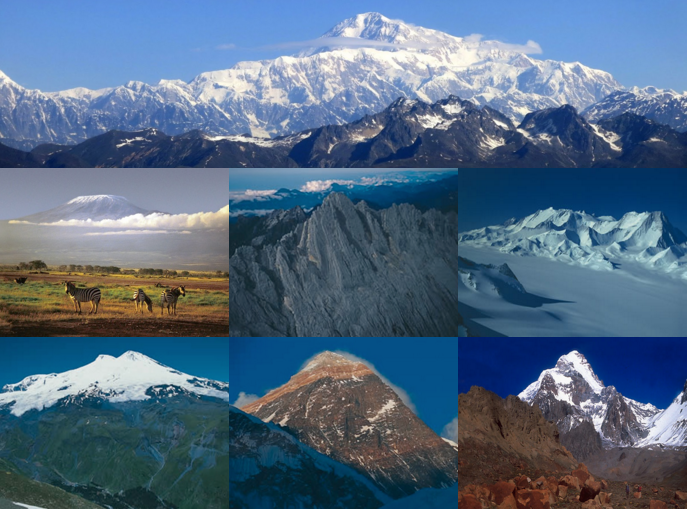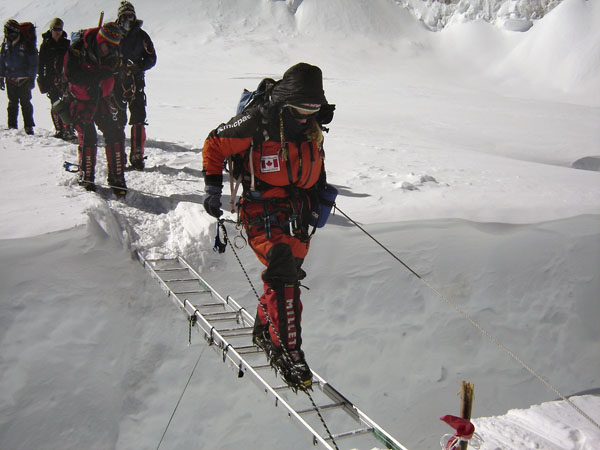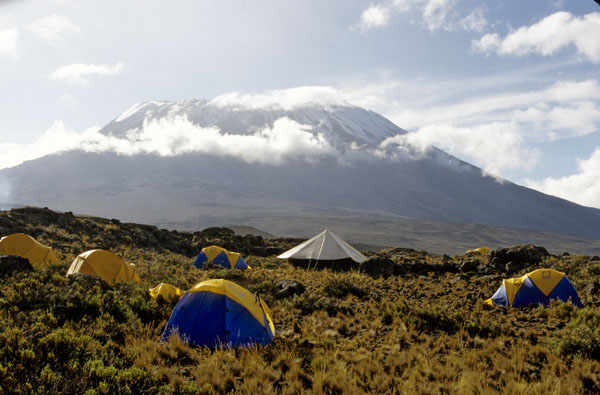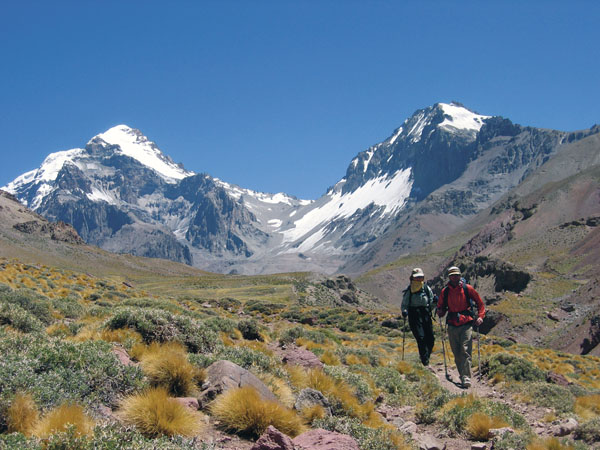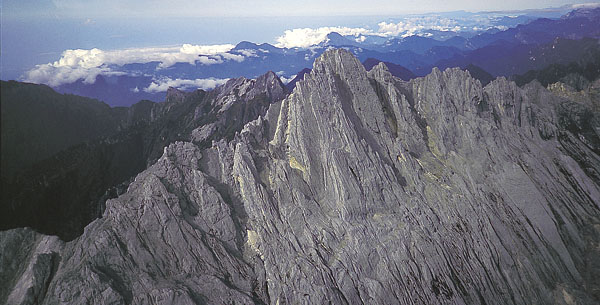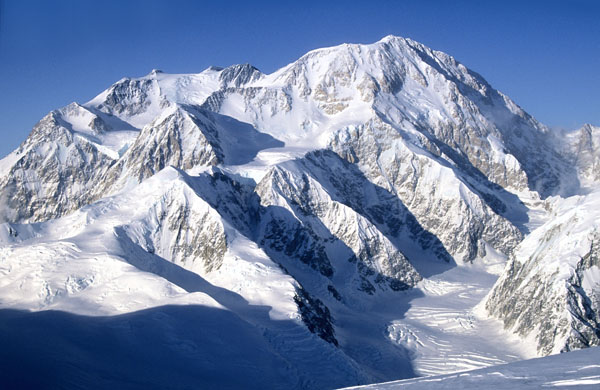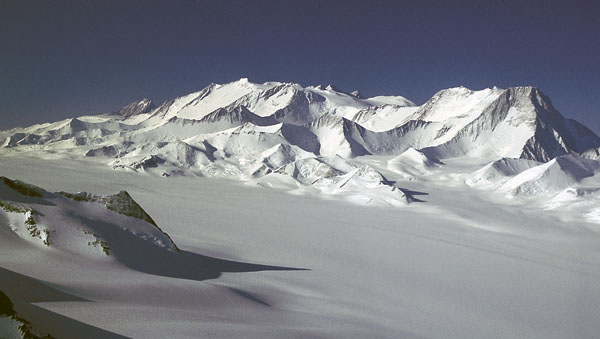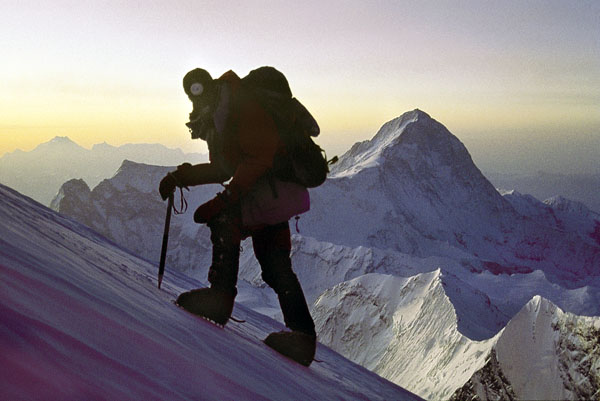Seven Summits Training Course Overview Denali from the southwest.
The Seven Summits draw a special breed of climber. More than fifteen years after the publication of “Into Thin Air” in 1996, high-altitude climbing in general and the Seven Summits in particular have only gained greater appeal. The popularity of the Seven has led to improved access and services for climbers, but it has also led to problems. Too many climbers take shortcuts in their preparation, compromising both enjoyment and safety.
The Seven Summits present a wide range of significant climbing challenges. Sometimes slighted by specialists as “walk-ups”, in reality they include summits that require a solid skill base in rock, ice, and snow climbing, in addition to outstanding endurance and altitude tolerance. Especially since the move to replace Mount Kosciusko in Australia with New Guinea’s Carstensz Pyramid on the main summit list, the project has come to be accepted as a considerable achievement by the climbing elite.
Skill Training Required for the Seven Summits
To complete the Seven, a climber must have skill training in all the major sub-disciplines of climbing with the sole exception of steep waterfall ice. These skills include:
General mountaineering skills such as ice-axe use and self-arrest, French crampon technique, and glacier travel practices
Alpine rock climbing and ice climbing at a moderate difficulty level
High-altitude and cold-weather mountaineering, camp fortification, and use of ladders and fixed lines.
AAI's Seven Summits Program comprises three distinct components that can be taken consecutively in a single 20 day course or broken into two or more phases, according to your needs. Please contact our office at 360-671-1505 to receive counseling on the best plan of action for you.
Seven Summits Training Course Training Phases Phase 1: Introduction to Mountaineering - Kilimanjaro, Elbrus, and Aconcagua
Based on our Introduction to Alpinism course plus a custom day of instruction and assessment with a private guide, this course provides a foundation of technical skills and knowledge that you will need on every mountain that you climb. While Kilimanjaro, Elbrus, and Aconcagua are all considered "non-technical" mountains, conditions on the latter two peaks require baseline mountaineering skills that should be fully ingrained before beginning the climbs. Most climbers will do well on these peaks after taking our introductory course.
Click on the "Dates and Locations" Tab, above, for specific trips.
Phase 2: Cold Weather Expeditions - Denali and Vinson
Descending from basecamp on Aconcagua. Jim Ledvinca
Based on our Denali Prep course plus an optional custom day with a private guide, this course will prepare you for cold weather expeditionary climbing. Many of the specific expedition skills, such as how to fortify a camp or how to ascend fixed lines on the ice, are covered in this class.
Many climbers need additional training to prepare for their ascents of Denali and Vinson . While we screen candidates for these expeditions on an individual basis, we sometimes suggest that climbers develop their skills on one of our Skills Expeditions , or do additional climbing with us on a private basis.
Click on the "Dates and Locations" Tab, above, for specific trips.
Phase 3: Alpine Rock Climbing and 8000-Meter Peaks - Carstensz Pyramid and Mt. Everest
The third phase of the Seven Summits program is the most involved. Carstensz Pyramid is a technical rock climb at altitude; Mt. Everest, because of its extreme height and massive ice falls, requires specialized skills not typically needed on any of the other peaks. To train for this phase, we put our climbers through our Alpinism 2 curriculum, plus an optional additional custom day of private instruction to cover use of ladders, altitude medication, and supplemental oxygen.
Some climbers choose to combine the Phase 1 and Phase 3 training in a single 12-day Alpine Mountaineering and Technical Leadership (AMTL) course. This is an excellent option for those who anticipate doing additional independent climbing along the way to completing the Seven Summits goal.
A further option available to climbers is to train for these higher end climbs on a private basis. Routes such as the East Buttress of Mount Whitney (14,505 ft., 5.7, III) provide good training for Carstensz. Preparation for Mt. Everest on a smaller 8,000 meter peak, such as Cho Oyu , is often recommended.
Click on the "Dates and Locations" Tab, above, for specific trips.
Seven Summits Training Course Dates and Locations Phase 1: General Mountaineering Training
Mt. Baker, Washington
Add 1 day on either end of dates shown for custom day of private training and equipment consultation:
Women's Specific Programs
Our women's specific programs are for all individuals who identify as female, and are taught by female instructors. That is the only difference. We cover the exact same skills and techniques as the co-ed courses, we go to the same venues and climb the same peaks.
Dates:
Phase 2: Cold Weather Expedition Training
Mt. Baker, Washington and Mount Rainier, Washington
Add 1 day on either end of dates shown for custom day of private training and equipment consultation:
Phase 3: Alpine Rock and 8,000 Meter Training
North Cascades, Washington
Add 1 day on either end of dates shown for custom day of private training and equipment consultation:
These courses are also offered in the Sierra Nevada, California on a private basis. Please contact our office at 360-671-1505 or email: [email protected] to arrange custom dates and locations for the Seven Summits Training Course.
Seven Summits Training Course Related Courses
Program Finder
By Location
United States - Alaska
United States - Washington
United States - California
United States - Nevada
United States - Colorado
United States - Utah
Canada - British Columbia
South America - Argentina
South America - Bolivia
South America - Ecuador
South America - Patagonia
South America - Peru
Europe - Alps and Caucasus
Asia - Nepal and Tibet
Asia - Laos, Thailand, & Vietnam
Asia - China
Asia - Japan
Africa - Tanzania
Pacific and Antarctica
By Program Type
Instructional Courses
Group Summit Climbs
Expeditions
Skills Expeditions
Private Guided Programs
Treks, Tours, & Backpacking
Corporate Outings & Services
Government & Military
By Activity
Rock Climbing
Ice Climbing
Alpine Climbing
High-Altitude Climbing
Trekking and Backpacking
Skiing & Snowboarding
Guide Training & Rescue
Avalanche Training
Departure Month
Difficulty Level
Beginner
Moderate
Intermediate
Advanced
Very Advanced
x
